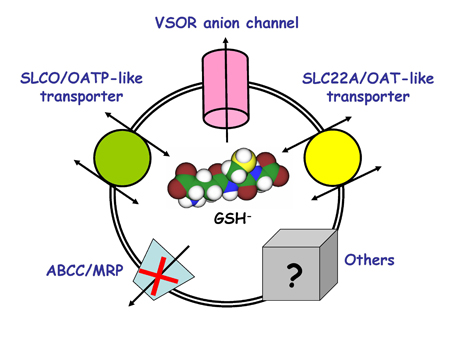Glutathione (GSH) is a negatively charged tripeptide found throughout the body. GSH is the most powerful endogenous anti-oxidant which is a major determinant of the cellular redox state, defense against oxidative stress and detoxification of xenobiotics. It is assembled inside and degraded outside the cells and is released under various physiological and pathophysiological conditions. The GSH release mechanism is poorly understood at present.
We report here that freshly isolated rat thymocytes respond to hypoosomotic stimulation with increased release of GSH. The release rate was around 8,000 molecules/sec/cell under isotonic conditions and 61,000 molecules/sec/cell under hypoosmotic conditions (50% osmolality). The relatively low activation energy (around 5 kcal/mol) strongly suggests a predominant diffusion mechanism of GSH translocation. The osmosensitive release of GSH was significantly inhibited by blockers of volume-sensitive outwardly rectifying (VSOR) anion channel. In patch-clamp experiments, anion replacement studies indicated that the thymic VSOR anion channel exhibits relatively high GSH permeability with the ratio of PGSH/PCl = 0.32 for influx and 0.10 for efflux, in light of the fact that the effective radius of GSH (~0.55 nm) is much larger than that of chloride (~0.18 nm). Also, it must be noted that the radius of VSOR channel pore vestibule (~0.62 nm: Ternovsky, Okada & Sabirov 2004 FEBS Lett) is suited to accommodate and pass GSH.
The osmosensitive GSH release was not inhibited by ABCC/MRP blockers (MK571 and probenecid), trans-stimulated by SLCO/OATP substrates (probenecid, taurocholic acid and estrone sulfate), and inhibited by an SLC22A/OAT blocker (PAH). The inhibition by PAH was additive to the effect VSOR channel blockers implying that SLC22A/OAT and VSOR are separate pathways. We provided, for the first time, firm evidence that the VSOR anion channel, in cooperation with OATP-like and OAT-like transporters, serves as a major pathway for the GSH efflux from osmotically swollen thymocytes, as schematically depicted in the Figure.
This work represents international collaboration among Institute of Bioorganic Chemistry (Academy of Sciences of Uzbekistan), National University of Uzbekistan (Prof. R.Z. Sabirov) in Tashkent and National Institute for Physiological Sciences (Prof. Y. Okada, Director-General) in Okazaki.
Sabirov R.Z., Kurbannazarova R.S., Melanova N.R. and Okada Y. (2013) Volume-Sensitive Anion Channels Mediate Osmosensitive Glutathione Release From Rat Thymocytes. PLOS ONE (online publication on January 30, 2013).
